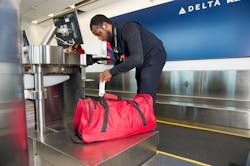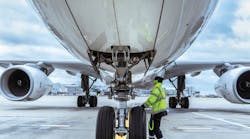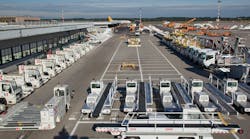With the number of mishandled bags continuing to fall, airports and airlines are being encouraged to embrace new technology within the next few years to keep numbers dropping.
The International Air Transport Association (IATA), has identified five common capabilities — identification, tracking, XML, data sharing and process automation — as the keys to a downward trend in lost baggage. Leaders say implementing these technologies and best practices can not only reduce costs associated with lost baggage, but create new and innovative business models to increase revenues while improving customer experience at airports across the world.
“Those five capabilities for the foundation of a world in which we can make it impossible to lose baggage,” said Andrew Price, head of airport operations for IATA.
Price participated in a May 4, webinar hosted by SITA highlighting current stats for baggage handling compiled in its 2016 baggage report. The data highlights progress made in improving baggage handling in recent years in the lead up to the implementation of IATA Resolution 753 by member airlines.
According to the report, the number of mishandled bags has dropped significantly in the past 12 years. In 2003, there were 1.89 billion passengers reported in the survey with 13.2 mishandled bags reported per 1,000 passengers. The number peaked in 2007 at 18.88 per 1,000 passengers, but in 2015, a record low of 6.5 bags per 1,000 passengers was reported.
Europe saw the number of mishandled bags drop from 16.6 per 1,000 passengers in 2007 to 7.8 in 2015. North America dropped from 7.05 to 3.24.
Asia continued to have the best rate of mishandled baggage going from 3.05 in 2007 to 2.02 in 2015.
The falling rate happened despite air traffic ballooning to 3.5 billion. The drop is due to implementation of new technology and best practices. Passenger numbers are expected to jump to 7 billion by 2034, so the additional strain on airport baggage systems will need to address soon.
“With a rate of 6.5, that’s still a total of about 23.1 million bags, so we must continue to strive to improve,” said Nick Gates, baggage portfolio director for SITA. “We still have a lot of work to do.”
Price said identification, tracking, XML, data sharing and process automation improvements can keep the number of mishandled bags falling in coming years. Real-time tracking would allow a passenger and all aspects of a bag’s movement. The implementation of XML would allow flexibility to enhance the system with future technology.
Price said a lot of airports still use Bingo cards to track data, but faxing those ahead to the next airport doesn’t really work anymore. If full baggage manifests were passed down the line of possession so everyone knows what’s coming to them in the movement process.
Data sharing between baggage handlers, airlines and airports would assist in lowering the amount of mishandled bags.
“The cost of handling a bag properly is about $10. When it’s mishandled, it’s about $100,” Price said. “That’s an average for the industry that adds up to a huge amount of money so we’re very interested in controlling those costs.”
The use if RFID technology for tracking bags can reduce baggage mishandling in the coming years by better tracking throughout the process.
On April 28, Delta Air Lines announced it was investing $50 million to implement RFID technology for bags at more than 340 airports by August. David Hosford, manager of baggage performance strategy, said the company piloted the technology at McCarren International Airport (LAS) in 2014 and it saw about 99 percent of all baggage tracked using the process
The new technology will improve Delta’s baggage performance and better Delta’s baggage mishandling rate, Hosford said, along with other improvements the airline is making to its to airports.
“One of the things that’s really the most exciting about the transition to RFID is the innovation, the move forward to the future,” Hosford said. “We’ve really used the barcode scanners hard and pushed that beyond what was perceived back in the day when they were putting that in place.”
The SITA report showed a growing interest in passengers for unmanned baggage drop off points. While more are expected to use the systems and to see the unmanned drop off points grow in the future, Price said it’s highly unlikely those positions will ever be fully eliminated by airports or airlines.
“The human touch, having people there, I think you’re always going to need that. There’s always going to be passengers that need this help so it’s not reasonable to expect all passengers to use a self-bag drop machine unassisted,” he said. “Some people often do like that human touch there to help you. We will see a lot more machines, but you will see a change in the way the airport and airline staff are used.
“They can be moved out from behind their desk to help the passengers.”



